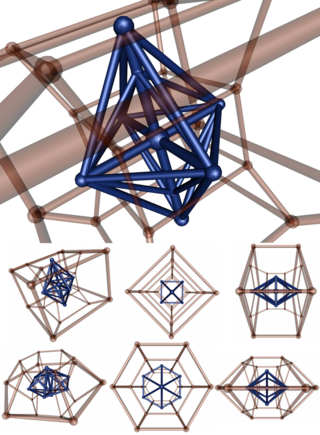| Set of uniform p,q-duopyramids | |
| Type | Uniform dual polychoron |
| Schläfli symbol | {p} + {q} |
| Coxeter-Dynkin diagram | |
| Cells | pq tetrahedra |
| Faces | 2pq triangles |
| Edges | pq+p+q |
| Vertices | p+q |
| Vertex figures | p-gonal bipyramid q-gonal bipyramid |
| Symmetry | [p,2,q], order 4pq |
| Dual | Duoprism |
| Properties | convex, facet-transitive |
| Set of uniform p,p-duopyramids | |
| Schläfli symbol | {p} + {p} |
| Coxeter-Dynkin diagram | |
| Cells | p2 tetrahedra |
| Faces | 2p2 triangles |
| Edges | p2+2p |
| Vertices | 2p |
| Vertex figures | p-gonal bipyramid q-gonal bipyramid |
| Symmetry | [[p,2,p]], order 8p2 |
| Dual | Duoprism |
| Properties | convex, facet-transitive, facet-transitive |
In geometry of 4 dimensions or higher, a duopyramid is a dual polytope of a p-q duoprism. As a uniform polychoron, it can be given Schläfli symbol {p} + {q}, and can be seen as two regular planar polygons of p and q sides with the same center and orthogonal orientations in 4 dimensions. Along with the p and q edges of the two polygons, all permutation of points in one polygon to the other form edges. All faces are triangular, representing one edge of one polygon connected to one point of in the other polygon. The p and q sided polygons are hollow, passing through the polytope center and don't define faces. Cells are tetrahedra constructed, one for every pair of edges, one from each polygon.
It can be considered in analogy the relation of the 3D prisms and their dual bipyramids with Schläfli symbol { } + {p}. A bipyramid can be seen as a 3D degenerated duopyramid, by adding an edge across the digon { } on the inner axis, and adding intersecting interior triangles and tetrahedra connecting that new edge to p-gon vertices and edges.
The regular 16-cell can be seen as a 4,4-duopyramid
A p,q-dupyramid has Coxeter group symmetry [p,2,q], order 4pq. When p and q are identical, the symmetry is doubled as [[p,2,p]], order 8p2.
Other nonuniform polychora can be called duopyramids by the same contruction, as two orthogonal and co-centered polygons, connected with edges with all combinations of vertex pairs between the polygons. The symmetry will be the product of the symmetry of the two polygons. So a rectangle-rectangle duoopyramid would have symmetry [2]x[2], order 16, possibly doubled if the two rectangles are identical.


